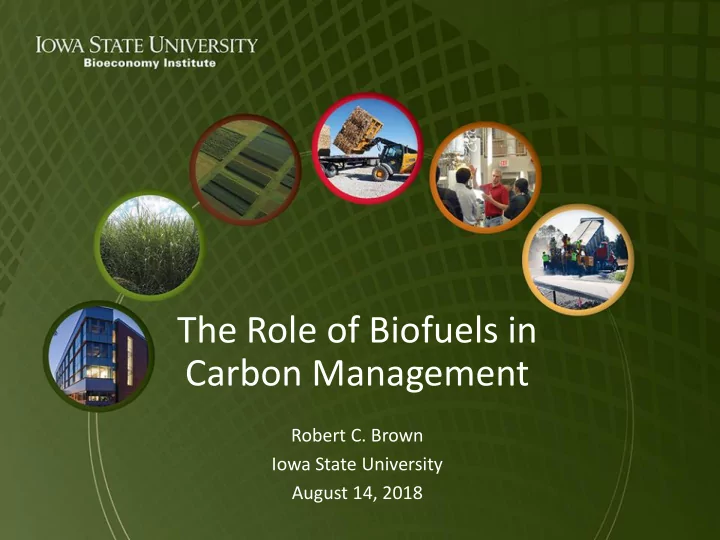

The Role of Biofuels in Carbon Management Robert C. Brown Iowa State University August 14, 2018
Why Are We Producing Biofuels? We have few other alternatives to: Develop sustainable • transportation fuels; • Dramatically reduce greenhouse gas emissions from transportation; • Achieve cost-effective carbon dioxide removal and sequestration from the atmosphere. 2
Biofuels: Plenty of options Advanced Conventional Butanol from starch crops Ethanol from starch crops Butanol from sugar crops Ethanol from sugar crops Biodiesel from oil crops Ethanol from cellulosic crops Biodiesel from waste oil Green diesel from waste oil Green diesel from algae Drop-in biofuels from cellulosic crops 3
Biofuels: Plenty of criticism “Biofuels are bad because__________” 4
Claim: There is no difference between the CO 2 emitted from burning ethanol and burning gasoline. Fact: Managing carbon requires an understanding of its source. 5
Climate policies increasingly call for Carbon Dioxide Removal and Reliable Sequestration (CDRRS) • 2014 IPCC Working Group III report highlights carbon negative energy • 2015 Climate Summit in Paris concludes that nations should work toward a balance between anthropogenic emissions by sources and removals by sinks of greenhouse gases 6
Carbon reduction vs carbon removal • Carbon reduction – reduce the rate at which carbon dioxide enters the atmosphere • Carbon removal – remove carbon dioxide from the atmosphere 7
Challenge of carbon The Daunting Challenge of Carbon removal: Extracting one Removal molecule from among 2,500 8
Som Some e Idea eas for or Ca Carbo bon Dioxide e Rem emoval a and R nd Rel eliable e Sequestration on ( (CDRRS) 9
Direct Air Capture • Draws air through a sorbent to remove CO 2 • Powered by photovoltaics or wind power 10
Mollusk Sequestration of CO 2 Current sequestration from world-wide shellfish farms • Removes CO2 dissolved in oceans • Powered by nature • Would require a 10,000 fold increase in shellfish farming to remove cumulative anthropogenic CO 2 within 50 years 11
Biomass Energy Carbon Capture and Sequestration (BECCS) http://www.centerforcarbonremoval.org/blog- posts/2015/11/3/theme-of-the-month-november-beccs 12
Surely agriculture can come up with carbon removal strategies! 13
Let’s store it in soils, like Iowa already does… Soil organic matter in the U.S. Hargrove and Luxmore (1988) 14
Agriculture-based Carbon Dioxide Removal and Reliable Sequestration (Ag-CDRRS) 15
Soil Carbon Management 16
Terrestrial ecosystems store most of their carbon in soils Eighty one percent in of the carbon in the earth's biosphere is stored in the soil while only nineteen percent is stored in plants (IPCC, 2000) http://www.willraap.org/2012/06/07/the-role-of-carbon- 17 sequestration-in-mitigating-climate-change/
Microbial Carbonate Precipitation (MCP) in Soils 18
Microbial Carbonate Precipitation (MCP) in Anaerobic Digestion 19
Pyrolysis-Biochar Platform 20
The pyrolysis-biochar platform stores carbon in soils as biochar… Carbon Negative Energy Carbon Positive Energy 21
…while supplying carbon negative energy for transportation and power 22
Key features of carbon negative energy • Fixes carbon from the atmosphere • Sequesters carbon in the biosphere (potentially providing ecosystem services) or the geosphere • Generates energy products that contribute to the nation’s economy 23
ISU strategy for obtaining energy products from biomass: Py refinery Autothermal Pyrolysis Product Recovery Lignocellulosic Biomass Unrefined Acetate Unrefined Sugars Phenolic Oil Biochar from Hemicellulose from Polysaccharide from Lignin First Generation Ethanol Fuels for boilers and Soil Amendment In-plant Products gas turbines thermal energy Potential -Pharmaceuticals -Transportation Fuels -Acetone -Activated Carbon Future Products -Polymers -Bio-asphalt -Acetic Acid -Biobased Chemicals -Bio-cement -Alcohols Pollard et al. (2012) Journal of Analytical and Applied Pyrolysis 93, 129-138. 24
Pyrolysis demonstration project • Partners: Iowa State University, Easy Energy Systems and Stine Seed Company • Technology: Modular Energy Production Systems (MEPS) based on ISU pyrolysis technology • Approach: Pilot scale research to guide design of 50 tpd demonstration plant • Products: Pyrolytic sugars, fuel oil substitute and biochar Fuel oil substitute Pyrolytic sugar Pilot plant (15-20 kg/h) used to design demonstration plant Modular Energy Production System Demonstration plant (50 tpd) Biochar Application 25
Summary • Biofuels is an opportunity to provide sustainable liquid fuels for transportation, reduce greenhouse gas emissions compared to petroleum and even achieve carbon negative energy • Carbon removal is increasingly recognized as important for mitigating global climate change – pyrolysis-based biofuels offers a pathway to carbon negative energy • ISU is demonstrating Py Refineries for production of sugars and phenolic oil with multiple energy and material applications and biochar for carbon negative energy 26
Recommend
More recommend